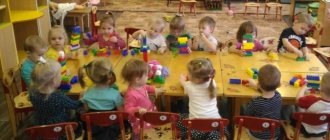"What changed?" — children's educational game with nesting dolls
The game develops the visual skills of preschool children. Trains a child, aged 3 - 4 years, to distinguish colors and sizes of objects, to remember the differences.
Type: Games with objects.
Didactic task: To train children in correctly naming objects and their actions (the nesting doll hid, ran, stood still), to notice and name the difference in the color of clothing and the size of the nesting dolls, to develop in children, aged 3 - 4 years, visual memory, voluntary memorization , observation, speech.
Game rule: Only the one who is named by the matryoshka - mother (the largest matryoshka) - answers.
Game action: Guessing what has changed in the arrangement of the nesting dolls.
Progress of the game: The teacher shows the children one by one five different-sized multi-colored nesting dolls. The children look at them. All nesting dolls are different in size and are dressed in different sundresses and scarves. Together with the children, the teacher names the colors of clothes and notes that all nesting dolls are different in size.
Children sit at a table in a semicircle; it is placed so that everyone can see the nesting dolls standing on the teacher’s table.
The teacher asks a question:
- Children, what do you see on my table? “Matryoshka dolls,” the children answer in unison. - Look at how tall the nesting dolls are. (Places two, then three, and then four nesting dolls next to each other.) Are they the same height or not? (“Different.”) What is different about them? Look carefully!
At first, the children find it difficult to answer correctly, the teacher helps them with leading questions:
- Look at the handkerchiefs. What are they? (Touches first one, then another nesting doll.) That's right. One nesting doll has a red scarf, another has a green one, and this one has a blue one. How can we say about handkerchiefs in one word? (“The nesting dolls have handkerchiefs of different colors.”) And sundresses? How can you say? Right. Their sundresses are also different. (Together with the children, name the color of each nesting doll’s sundress: red, green, blue.) Look at them and remember how the nesting dolls are dressed.
Now let’s play like this: I’ll cover the matryoshka dolls with a screen, and then you’ll find out which doll will hide. But you need to answer only one at a time, so the one who notices will come up to me and say quietly so that others do not hear. Next, the teacher draws the children’s attention to the size of the nesting dolls: he hides behind the screen first one, then another, then two at once.
When the game is played again, the one the matryoshka points to answers.
You can use other items in this educational game, depending on what problems are being solved.
Features of organizing didactic games for younger preschoolers
Olga Ovchinnikova
Features of organizing didactic games for younger preschoolers
Features of organizing didactic games for younger preschoolers
For the successful organization of didactic games, there are three main stages: preparation of the didactic game , its actual implementation, and also the results of the game.
In preparation, the teacher selects a didactic game that would meet the objectives of education and training, and also correspond to a certain age group. The teacher must determine the most convenient time, as well as the location of the didactic game . He must prepare the necessary didactic material for the chosen game, which must be colorful, large, durable, and have content that the child can understand. The teacher must prepare himself, and it is very important to prepare children for the game, since the game most often relies on the knowledge that children already have.
Next, the teacher conducts a didactic game , where he: introduces the children to the content of the game, to the didactic material that will be used in the game; explains the course and rules of the game.
Each age group has its own characteristics of conducting a didactic game . Let's consider the features of conducting it in the younger group . Children of primary preschool age have poorly developed coordination of movements, as well as a low level of sensory and especially motor speech , therefore, teaching objective actions should be mainly individual or in small subgroups. It is advisable to repeat the same games with children several times. Didactic games are held daily. The duration of games depends on their content and should not exceed 5-8 minutes. It is important to remember that when conducting a didactic game, children should not be overtired. A didactic game should bring joy and a sense of satisfaction from solving the problems posed in it.
With the help of didactic games, children of primary preschool age learn to examine objects and become familiar with their various features. Didactic games also require children to verbally designate these signs, which promotes the development of an active vocabulary. Some games give an idea of the different shapes, colors and sizes of objects ( "Wonderful Bag"
,
“Find the same object as mine”
,
“Collect a flower”
,
“Hide the hedgehog”,
etc.).
Other games teach the child to group objects according to one or another characteristic ( “Big and small”
, “Find a house for the animals
(of the appropriate color)
. Children learn to compare objects that have similar and different characteristics. In this way, children are led to mastering sensory standards with the help of
didactic games
At the end of the didactic , the results are summed up, from which it is possible to identify which techniques, during the preparation and conduct of the didactic game , turned out to be the most effective in achieving the objectives, as well as whether it will be used with interest by children in independent play activities.




